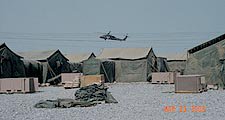Communication a problem for orthopedist in Kuwait
Orthopedic surgeons face challenges in treating casualties of Iraq conflict.
When the bombs began falling on Baghdad to signal the start of the Iraq War, U.S. Army Major Shawn Patrick Granger, MD, had been in Kuwait with the 115th Field Hospital for two weeks preparing to treat potential casualties.
But certain medical supplies crucial to the unit’s only orthopedic surgeon were not so punctual.
“We arrived to the usual chaos of a large-scale deployment,” Granger told Orthopedics Today via e-mail from Camp Arifjan, Kuwait.
That chaos included the discovery that a power drill was not part of the medical supplies delivered a week prior to the March 20 start of the conflict.
“Fortunately, I received our power drill two days into the hostilities and four hours before our first fracture cases arrived. I placed an external fixator and plated a humerus shaft fracture that day,” Granger said.
Equipment delayed
 ---The 115th
field hospital in Kuwait.
---The 115th
field hospital in Kuwait.
COURTESY OF
SHAWN PATRICK GRANGER
Also not delivered as scheduled were a dozen Stryker drills, a C-arm, cannulated screws, intramedullary nails or a supply of screws other than basic small-, mini- and large-frame sets and K-wires.
Granger, a West Point graduate, is chief of surgery at Baynes Jones Army Community Hospital in Fort Polk, La. He specializes in arthroscopy and sports medicine, but Iraq was, of course, was another matter.
“The majority of our experiences were with shrapnel injuries from RPG [rocket propelled grenade] rounds and motor vehicle accidents with some ejections as the troops scurried up and down the perilous MSRs [mission supply routes] playing bumper cars in clouds of dust from the blowing sands,” Granger said.
Shrapnel removal became so common that Granger and his fellow physicians renamed the operating room tent the “115th Shrapnel Mining Company.” Once removed, shrapnel pieces were given to the soldiers to take home as Iraqi souvenirs, Granger said.
Granger said he also pinned numerous hand cases as the fighting began, so many that the camp ran out of .045 K-wires.
Upon arrival in Kuwait, the situation for routine and emergent care was grim, with only three primary care doctors working sick call for a camp of about 12,000 troops, Granger said. But numerous physicians passed through camp and helped as much as possible before moving on, he said.
The camp included a tent hospital and a clinic. Equipment included two radiology machines, though no CT or MRI machines. Granger said digital imaging equipment was provided but the printer broke after the first week.
Granger described communication as a “significant problem, as we had no pagers, no cell phones and no radios. We survived by letting each other know where we would be when we left for the clinic, dinner or the gym.”
The clinic was a half-mile from the tent hospital, setup in a warehouse building divided with plywood sheets and 2-by-4’s, Granger said.
“That was quite a large amount of land to cover, but by some uncanny ability I always seemed to be headed to the hospital when the ER was receiving patients. Luckily, there were not many truly emergent patients at our location,” Granger said.
The clinic provided about two cases a day for Granger, including wrist fractures, fingers fractures and knee injuries from routine duties like loading or jumping out of trucks, and recreation activities such as playing basketball.
Granger said he spent about four to six hours at the clinic in the afternoon, operating in the morning or at night, as well as performing rounds at the tent hospital.
Chain of treatment
The camp was at the end of the Medivac chain of treatment. Initial care was typically done by the FST (forward surgical team) or CSH (combat support hospital), Granger said.
Most patients treated at the 115th Field Hospital were American servicemen, Army soldiers and Marines who had been treated, even if only with basic dressings, prior to arrival.
“Most have an undying desire to return to the front, to rejoin their unit and continue to fight,” Granger said in an April 17 e-mail.
That desire to fight was typified by a 19-year-old Marine who offered to pay for clearance to rejoin his unit only a day after Granger repaired his finger, which sustained a crush injury when a weapon broke and gouged his fingertips, destroying the radial lateral band.
The payment was rejected, and the young Marine returned to his unit in Baghdad five days later, Granger said.
Instead of returning home, Granger was sent to Camp Dogwood, located about 15 miles south of Baghdad. In only his second day there, he did five cases, which he said were varied and had a “higher acuity level than in Kuwait.”
